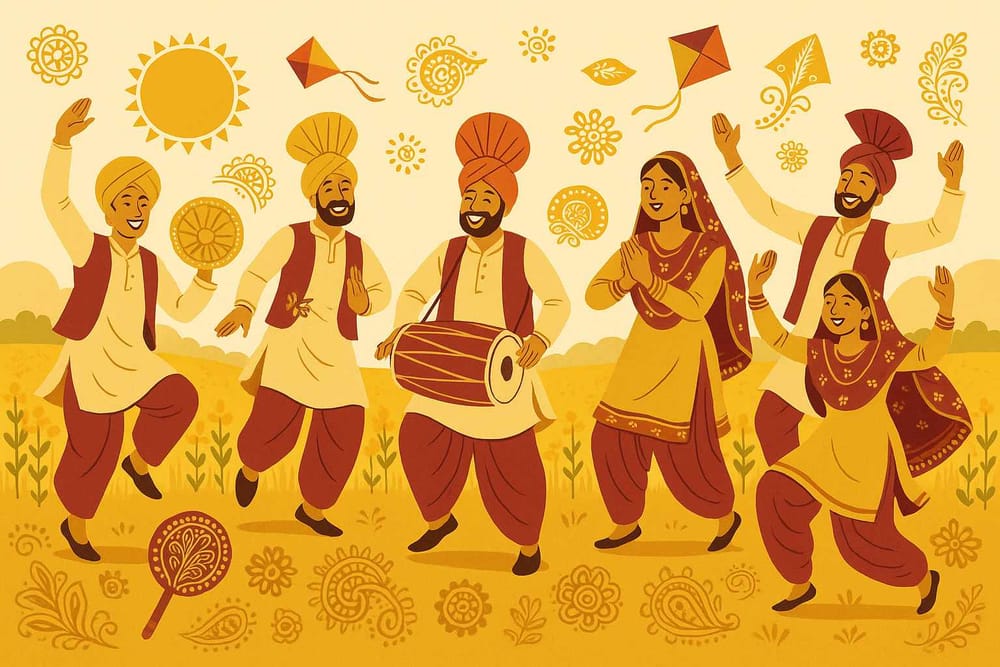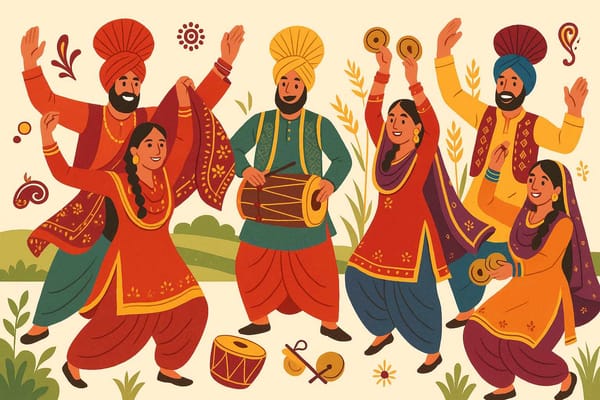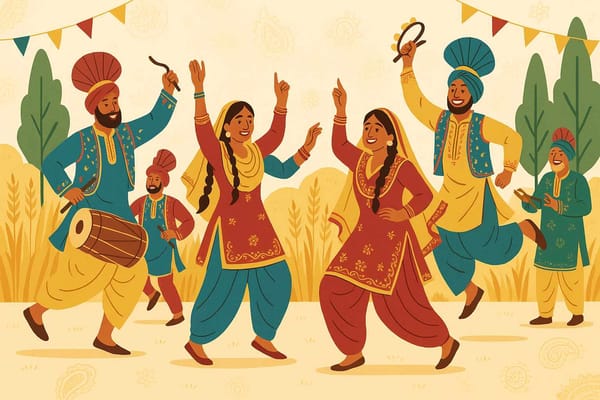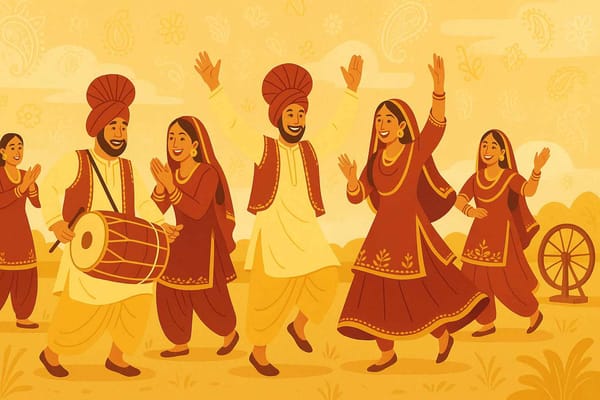
Punjab's Folk Dances Vibrate: An Exploration of Rhythms
Have you ever felt a beat so powerful that your feet start tapping on their own? That’s the magic of Punjab’s folk music for you. It’s more than just a sound; it’s the very heartbeat of its soil, its people, and its stories. The folk dances of this vibrant land are not mere performances; they are joyous explosions of life, gratitude, and a spirit that never gives up. They are stories told not with words, but with every twirl, every jump, and every clap.
Growing up, every wedding and every festival was filled with these rhythms. It’s a feeling of community, of shared happiness that is hard to put into words. Let's take a journey together into this world, where every step is a celebration of heritage.
Where the Rhythms Were Born: The Soulful Origins of Punjabi Dance
The story of Punjab's folk dances begins in its lush green fields. These dances are deeply connected to the agricultural life of the people. Imagine the joy of farmers after a bountiful harvest of wheat. This feeling of gratitude and success found its expression in dances performed during festivals like Vaisakhi. The movements themselves often mimic farming activities—the sowing of seeds, the harvesting of crops, and the sheer energy of working on the land. It’s a beautiful tribute to Mother Earth.
But it's not just about farming. These dances are woven with threads of folklore, mythology, and the core Sikh philosophy of 'Chardi Kala'—a state of eternal optimism and high spirits. This philosophy is visible in the high-energy, smiling performances that showcase a deep-seated resilience and hope, no matter the circumstances. These dances started as a way for entire villages to come together, to strengthen their bonds and share their stories, creating a powerful sense of unity.
Bhangra: The Joyful Roar of Punjab
When you think of Punjabi dance, the first thing that probably comes to mind is Bhangra. And rightly so! It is the most famous and energetic folk dance from this region. Bhangra is not just a dance; it is an emotion, an uncontainable expression of pure happiness.
The moment the dhol starts its pulsating beat, something shifts in the air. This powerful double-headed drum is the soul of Bhangra, driving the dancers into vigorous jumps, high kicks, and coordinated shoulder movements. Traditionally performed by men to celebrate the harvest, each step radiates strength and positivity. Dancers wear colourful turbans (Pagdi), flowing kurtas, and traditional lungis, their vibrant attire reflecting the pride of Punjabi culture. Today, Bhangra has travelled from the villages of Punjab to stages across the world, with modern versions blending beautifully with hip-hop and pop, yet its traditional soul remains untouched.
Giddha: The Graceful Storytelling of Punjabi Women
If Bhangra is the thunderous roar, then Giddha is the graceful echo. This is the counterpart dance form, traditionally performed by women. Giddha is a beautiful spectacle of feminine elegance, strength, and playful camaraderie. You’ll often see it at weddings, teej festivals, and family gatherings.
What makes Giddha truly special are the Boliyan—short, witty verses or folk poems that the women sing while dancing. These verses talk about everything from domestic life and relationships to playful banter and social commentary. The dance is characterized by rhythmic clapping and intricate hand gestures that tell a story. Dressed in vibrant Salwar-Kameez and intricately embroidered phulkari dupattas, the women spin and move in a circle, creating a mesmerising display of unity and shared heritage. Giddha is a powerful platform for women to express themselves, to laugh together, and to celebrate their culture with grace and pride.
Beyond Bhangra and Giddha: Other Folk Treasures
While Bhangra and Giddha are the most well-known, Punjab’s cultural tapestry is rich with many other folk dance forms, each with its own unique charm.
- Jhumar: This dance, whose name literally means 'swaying,' is a more gentle and graceful form. Often performed in a circle, its movements are slower and more rhythmic, almost like the swaying of trees in a breeze. Jhumar is a dance of deep emotion, often exploring themes of love and longing.
- Sammi: A traditional dance performed by women, Sammi originates from the Sandalbar region of Punjab. It's a dance of grace and simplicity, with circular movements that symbolize unity and harmony. The dancers often sing a soulful song called 'Sammi Meri Waari,' adding a touch of melancholy and love to the performance.
- Kikli: A delightful and playful dance performed by young girls. Two participants hold hands crosswise and spin around in a circle, laughing and singing folk songs. It’s a beautiful representation of friendship, sisterhood, and the simple joys of youth.
- Luddi: This is a celebratory dance, often performed by men to mark a victory or a significant achievement. The movements are energetic, involving distinct hand gestures and snake-like movements of the upper body, showcasing a sense of triumph and collective joy.
The Instruments: The Lifeblood of the Dance
You can't have a Punjabi folk dance without its soul-stirring music. The instruments are not just accompaniments; they are the very lifeblood that breathes energy into every performance. The mighty dhol leads the charge with its powerful beats, while the tumbi, a single-stringed instrument, adds a playful, high-pitched melody. The algoza, a pair of wooden flutes, creates a beautiful, continuous folk tune that is simply enchanting. Together, these sounds create an electrifying atmosphere that makes it impossible to stand still.
This beautiful synergy of music and movement is a core part of The Rhythm of Heritage, where folk music and dance define culture in its purest form.
From Punjab's Fields to the World's Stage
Today, the vibrant rhythms of Punjab have crossed borders and captured hearts all over the world. From flash mobs in Times Square to international Bhangra competitions, these folk dances are a global phenomenon. Bollywood has played a huge role in popularizing them, bringing their energy to the silver screen. But more importantly, for the vast Punjabi diaspora living abroad, these dances are a vital link to their roots, a way to keep their heritage alive and pass it on to the next generation. It’s a beautiful reminder that no matter where you are, you can always connect to your culture through the universal language of dance.
At Bhaktilipi, We Cherish These Traditions
At Bhaktilipi, we believe that understanding these cultural expressions is a form of devotion in itself. Exploring the depth of Indian cultures' vibrancy and its spiritual roots is at the heart of what we do. We strive to bring you stories and insights that connect you to the rich tapestry of our traditions.
Just as these dances tell timeless stories of Punjab, our platform, Bhaktilipi.in, is a treasure trove of devotional literature and cultural wisdom from every corner of India. We are dedicated to preserving and sharing this knowledge in a way that inspires and connects with you today. To stay connected with your roots, subscribe to our newsletter and follow us on Facebook, Instagram, and YouTube for regular updates.
A Rhythm That Will Last Forever
Punjab's folk dances are more than just art; they are the living, breathing soul of its people. They are a testament to a culture that celebrates life with open arms, finding joy in community, and expressing gratitude with every beat. From the powerful energy of Bhangra to the poetic grace of Giddha, these rhythms carry the legacy of generations. By celebrating and preserving these beautiful traditions, we ensure that the dhol's echo will continue to resonate in our hearts for years to come, reminding us of our vibrant heritage.
A passionate group of people dedicated to preserving India's knowledge of Dharma, Karma, and Bhakti for ourselves and the world 🙏.
Comments
Related in

The Vibrant Folk Dances of Punjab- A Complete Guide
Close your eyes for a moment. Can you hear it? That distant, thunderous beat of a dhol? That sound is more than just music; it's the very heartbeat of Punjab. It’s a call to celebration that echoes through the golden mustard fields and bustling village squares. The

Exploring the Enchanting Folk Dances of Punjab - A 2025 Guide
There's a certain magic in the soil of Punjab, a land where golden fields stretch as far as the eye can see and the air hums with stories of courage and celebration. This vibrant energy, this zest for life, isn't just in its famous cuisine or

Punjab Folk Dances-A Vibrant Exploration
Close your eyes for a moment. Can you hear it? The powerful, infectious beat of a dhol that makes your heart thump in rhythm. Can you see it? A whirlwind of bright colours, joyous smiles, and feet that seem to defy gravity. This is the very essence of Punjab, a
